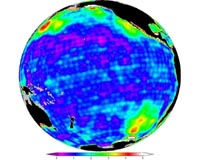|
|
|
New Look At Gravity Data Sheds Light On Ocean And Climate Pasadena CA (SPX) Aug 28, 2009  A discovery about the moon made in the 1960s is helping researchers unlock secrets about Earth's ocean today. By applying a method of calculating gravity that was first developed for the moon to data from NASA's Gravity Recovery and Climate Experiment, known as Grace, JPL researchers have found a way to measure the pressure at the bottom of the ocean. Just as knowing atmospheric pressure a ... read more
A discovery about the moon made in the 1960s is helping researchers unlock secrets about Earth's ocean today. By applying a method of calculating gravity that was first developed for the moon to data from NASA's Gravity Recovery and Climate Experiment, known as Grace, JPL researchers have found a way to measure the pressure at the bottom of the ocean. Just as knowing atmospheric pressure a ... read moreThe 40-Year-Old Dream  Tucson AZ (SPX) Aug 26, 2009
Tucson AZ (SPX) Aug 26, 2009It's time to find out if humans can permanently live and work in space, according to an article written by Mark Sykes and published in the Arizona Daily Star, Tucson, Arizona's morning newspaper. "This has never been a part of U.S. space policy, despite a long history of public relations implying the opposite," Sykes says. Sykes, CEO and director of the Tucson-based Planetary Science ... more
|
Vietnam says parched Red River at record low
China to be world's third biggest wind power producer: media Cost-cutting NASA eyes three cheap space missions Honduras declares state of emergency amid drought Russia in secret plan to save Earth from asteroid: official Sarkozy scrambles to salvage carbon tax French carbon tax ruled illegal Brazil's Lula signs law cutting CO2 emissions 2009 a 'benign' year of natural disasters: German re-insurer Greenpeace Spain demands Denmark release its director
| |||||||||||||||
| Previous Issues | Aug 27 | Aug 26 | Aug 25 | Aug 24 | Aug 23 |
| . |
The Ultimate Long Distance Communication White Sands NM (SPX) Aug 20, 2009
White Sands NM (SPX) Aug 20, 2009Anyone who's vacationed in the mountains or lived on a farm knows that it's hard to get good internet access or a strong cell phone signal in a remote area. Communicating across great distances has always been a challenge. So when NASA engineers designed the Lunar Reconnaissance Orbiter (LRO), they knew it would need an extraordinary communications system. Over the next year, the LRO, NASA ... more Microsats For The Moon  Sydney, Australia (SPX) Aug 20, 2009
Sydney, Australia (SPX) Aug 20, 2009For decades, microsatellites have been a boon to spaceflight. A small satellite can be built and launched fairly cheaply, sometimes hitching a ride for free aboard a large satellite launch. So far, microsatellites have not ventured very far into space. Could one go all the way to the Moon? Amateur groups have speculated on this possibility for years, but none have actually built a bird and ... more India And Russia Complete Design Of New Lunar Probe  New Delhi, India (RIA Novosti) Aug 18, 2009
New Delhi, India (RIA Novosti) Aug 18, 2009India and Russia have finished the design of a second unmanned lunar orbiter to be sent to the Moon in 2011-2012, the Indian Express newspaper said on Monday. The paper quoted Madhavan Nair, chairman of the Indian Space Research Organization (ISRO) as saying in Bangalore on Sunday: "Right now, the design has been completed. We had a joint review with Russian scientists here." ... more |
. |
| . |
India Mulls Using Nuclear Energy To Power Chandrayaan II Mumbai, India (SPX) Aug 14, 2009
Mumbai, India (SPX) Aug 14, 2009India plans to power some parts of the Chandrayaan II--its next unmanned mission to the moon- with nuclear energy and the feasibility studies are being carried out by Indian Space Research Organisation and Bhabha Atomic Research Centre. "We are thinking of powering some parts of Chandrayaan II with nuclear power and it will power the spacecraft when it revolves aroung the dark side of the ... more Clouds Discovered Over Titan Tropics  Flagstaff AZ (SPX) Aug 14, 2009
Flagstaff AZ (SPX) Aug 14, 2009In a case of persistent interplanetary detective work using powerful ground-based telescopes, a team of astronomers located and tracked the first bright but transient clouds over tropical latitudes on Saturn's moon Titan. The astronomers used the Gemini North telescope and NASA's Infrared Telescope Facility (IRTF) in an almost-nightly observing program providing new insights into the nature of ... more Huge Storm Detected On Titan  Mauna Kea hi (SPX) Aug 14, 2009
Mauna Kea hi (SPX) Aug 14, 2009A paper that describes the first storm observed in the tropical latitudes of Saturn's moon Titan will be published in the journal Nature on August 13. The rain from large clouds such as these is actually liquid methane and may be responsible for forming the channels and other features near the equator observed by the Huygens probe in 2005. The huge storm, observed with the NASA Infrared ... more |
. |
| Previous Issues | Aug 27 | Aug 26 | Aug 25 | Aug 24 | Aug 23 |
| The contents herein, unless otherwise known to be public domain, are Copyright 1995-2009 - SpaceDaily. AFP and UPI Wire Stories are copyright Agence France-Presse and United Press International. ESA Portal Reports are copyright European Space Agency. All NASA sourced material is public domain. Additional copyrights may apply in whole or part to other bona fide parties. Advertising does not imply endorsement, agreement or approval of any opinions, statements or information provided by SpaceDaily on any web page published or hosted by SpaceDaily. Privacy statement |